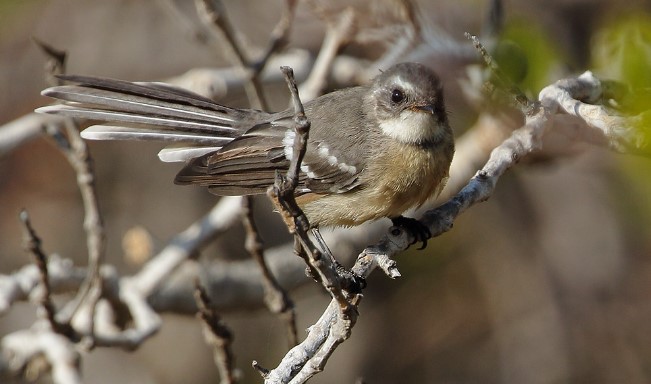Family: Mangrove Fantail (Rhipidura phasiana) is replacing the Grey Fantail in the mangroves of northwestern Australia. It belongs to the family Rhipiduridae.
Call & Song: In contact with both sexes, the Mangrove Fantail calls sharply, thinly, and chipped. Mangrove Fantails sing a tinkling song consisting of a series of high-pitched, squeaky downward notes.
Behavior and Habitats: A Mangrove Fantail resembles a Gray Fantail in appearance, but its throat bar is a gray smudge, its bill is larger and its tail is shorter with round-tipped feathers. The habits of this bird are also similar to those of the Grey Fantail.
In mangrove forests, Mangrove Fantails hawk insects on sallying flights from one-seven meters above tidal mud, alone or in pairs. Birds spend much of their time gleaning among branchlets and leaves, spiraling up and down trunks, along branches, and fluttering through upper foliage. The wings droop and the tail is spread, angled upwards, and twists as the bird moves.
Mangrove Fantails generally forage in strata above those occupied by Rufous Fantail in shrubbery below. There is a lack of knowledge about movements. While breeding adults are probably sedentary, there seems to be local wandering, especially around Arnhem Land and the Gulf of Carpentaria where the fantail is much scarcer than further west.
Size: Mangrove Fantails measure about 145-150 mm in length.

Identification: As adults both sexes have similar characteristics. There is a plain mid-grey color on the upper parts. Tail feathers broadly rounded, the outer five pairs white-tipped with broad edges; wings and tail cover duskier gray, wing covers tipped narrowly in two thin broken bars; inner secondaries small and narrowly edged with white.
There is an obsolete white stripe behind the eye and a deep gray face with a narrow white brow. An upper throat bar is dull mid-grey; a lower throat bar is dull white. There is a sandy-buff color to the underparts, a whiter tail, and a grayer flank color. The eyes are black. The lower mandible is mostly cream; the bill is black. The feet are blackish in color. Immatures are duller than adults and have obsolete markings.
Nest and Breeds: Nesting and breeding take place between July and December. The nest consists of a small 100 mm tailed cup of plant fiber smoothly embedded in a cobweb; lined with fine fiber; placed on a horizontal fork in the mangrove shrubbery, 1-4 m above the mud.
Eggs: The Mangrove Fantail lays two or three pale buffy cream eggs, minutely flecked and blotched with various browns, in zones. The eggs are oval and about 15 x 12 mm in size.
Distribution: It is found from about Carnarvon, WA, to the eastern head of the Gulf of Carpentaria, Qld, in close proximity to seaward and estuarine mangroves. Southern New Guinea is also home to this species. There are no races.
Read More – The Stunning Pink Robin







